10 Entrepreneurial Operating System Software for Businesses
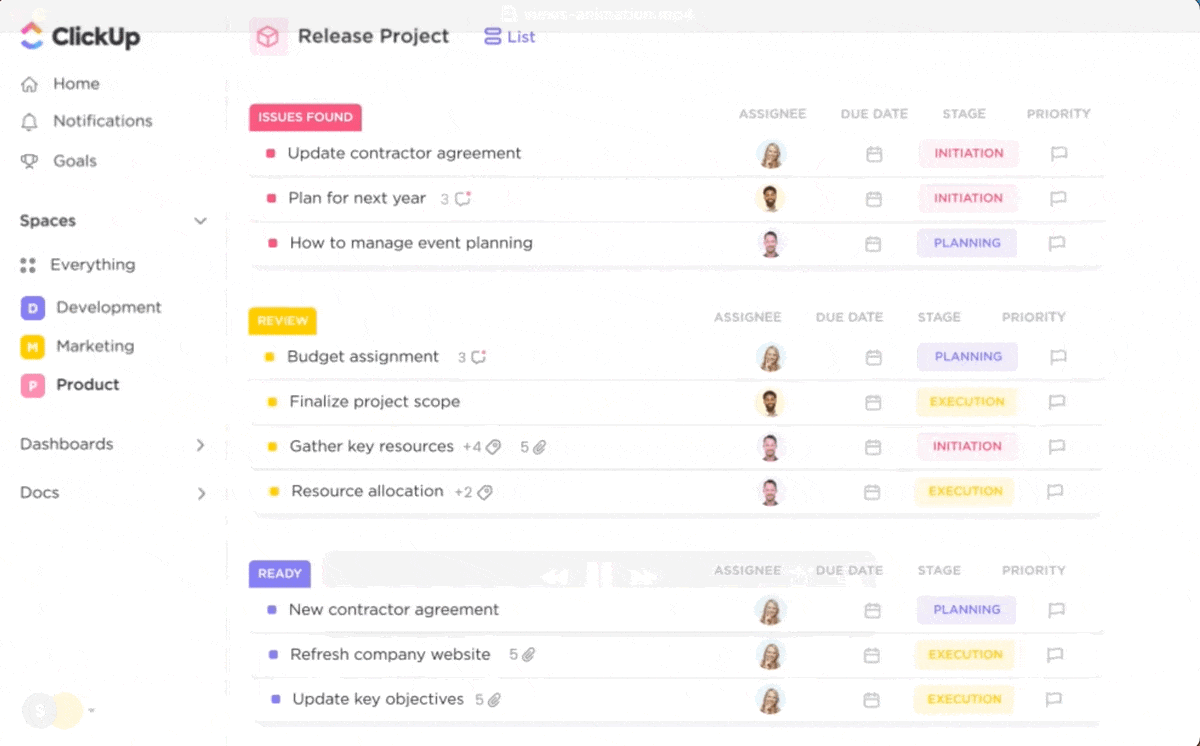
Sorry, there were no results found for “”
Sorry, there were no results found for “”
Sorry, there were no results found for “”

Every entrepreneur can benefit from the right framework to help grow the business and standardize operations. Many entrepreneurial operating system software tools, from project management to scorecards, can get everyone on the same page within the Entrepreneurial Operating System EOS framework. But you have to get the framework right first.
That’s where the EOS model comes in. Done right, it pulls together various parts of business operations and strategy together to create a single structure upon which everything else can be built.
Suddenly, your business management software has a higher purpose and goals needed to follow a proven process. Building your EOS toolbox can be an invaluable asset as a business owner.
In business management, EOS is a framework that guides your business model. The framework comprehensively looks to turn your company’s vision into a clear understanding of what needs to be done every day for your organization.
There is no single tool to help with that entire framework. Even the best operations management software won’t be enough, given its complexity. Instead, you’ll need to implement EOS through a few foundational tools addressing a different process component of the more extensive system.
Through entrepreneurial operating system software, these practical tools will share the same goals, setting clear expectations for everyone in the company. We’ll share some of the best entrepreneurial operating system software in this blog, helping you build and expand your EOS toolbox to better reach your company’s goals.
You need the right practical tools to embrace the EOS model with entrepreneurial operating system software. To get to that point, you need to identify areas that the tools you’re evaluating all have in common. It doesn’t matter whether you’re implementing process management software or ecommerce software.
These six components will always remain important for the right tools to get a grip on your business processes:
Many businesses will naturally look for tools that feature at least some of these six critical components of entrepreneurial operating system software. Embracing all of them makes sure when you choose your tools, anyone from human resources to your management team can get on the same page and work together to implement the more extensive operating system.
It’s time to dig into the details of entrepreneurial operating system software.
Note: Because there is no comprehensive tool for the entire operating system, you’ll need to find a menu of EOS-related platforms to help you build the larger framework. We’ve listed the comprehensive solutions with pricing and reviews, but this information is unavailable or not applicable to some.
These are our favorite options for entrepreneurial operating system software, ranging from simple tools to comprehensive platforms—all designed to solve issues relevant to your vision and achieve long-term success for the organization.
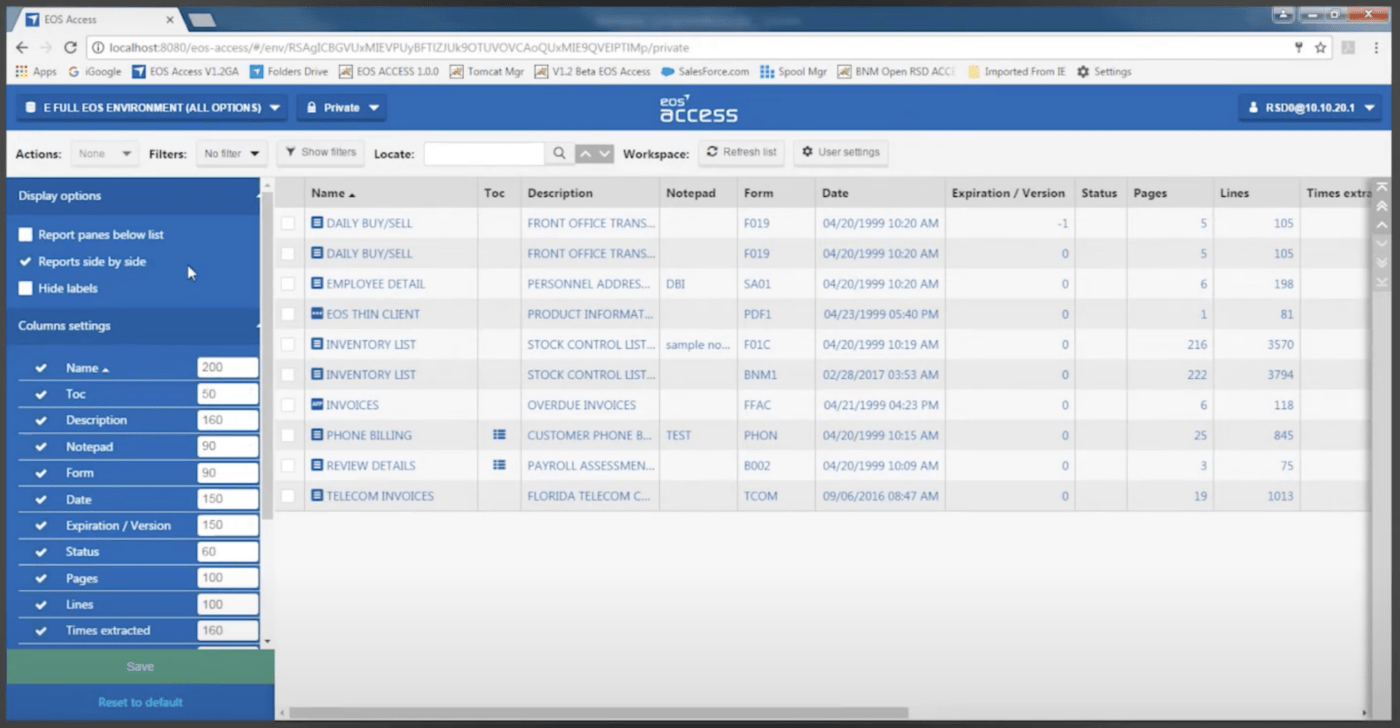
Any effort to talk about entrepreneurial operating system software for businesses has to start with a data solution. Enter Rocket EOS 360, a platform custom-designed to manage all of the quantitative outputs your small business provides. It takes care of administrative tasks your IT team would otherwise have to tackle, streamlining data resources for better business performance.
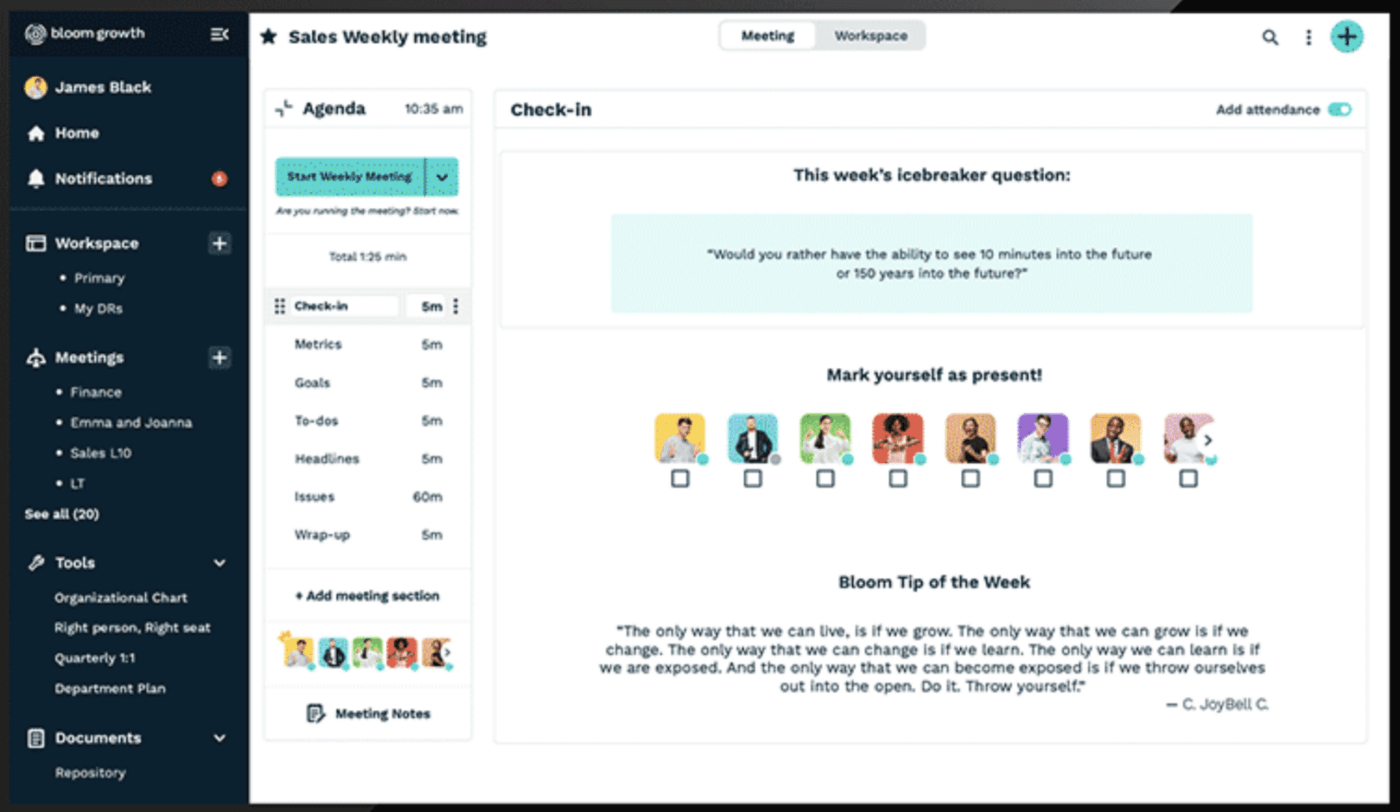
The tool formerly known as Traction Tools remains a robust “ecosystem for growth” for entrepreneurs and larger businesses alike. It helps with nearly every part of managing your business, including managing productivity and meetings alike, to help with anything from business models to tracking its overall performance. There is no single operating system to account for the entire EOS framework, but Bloom Growth sure comes close.
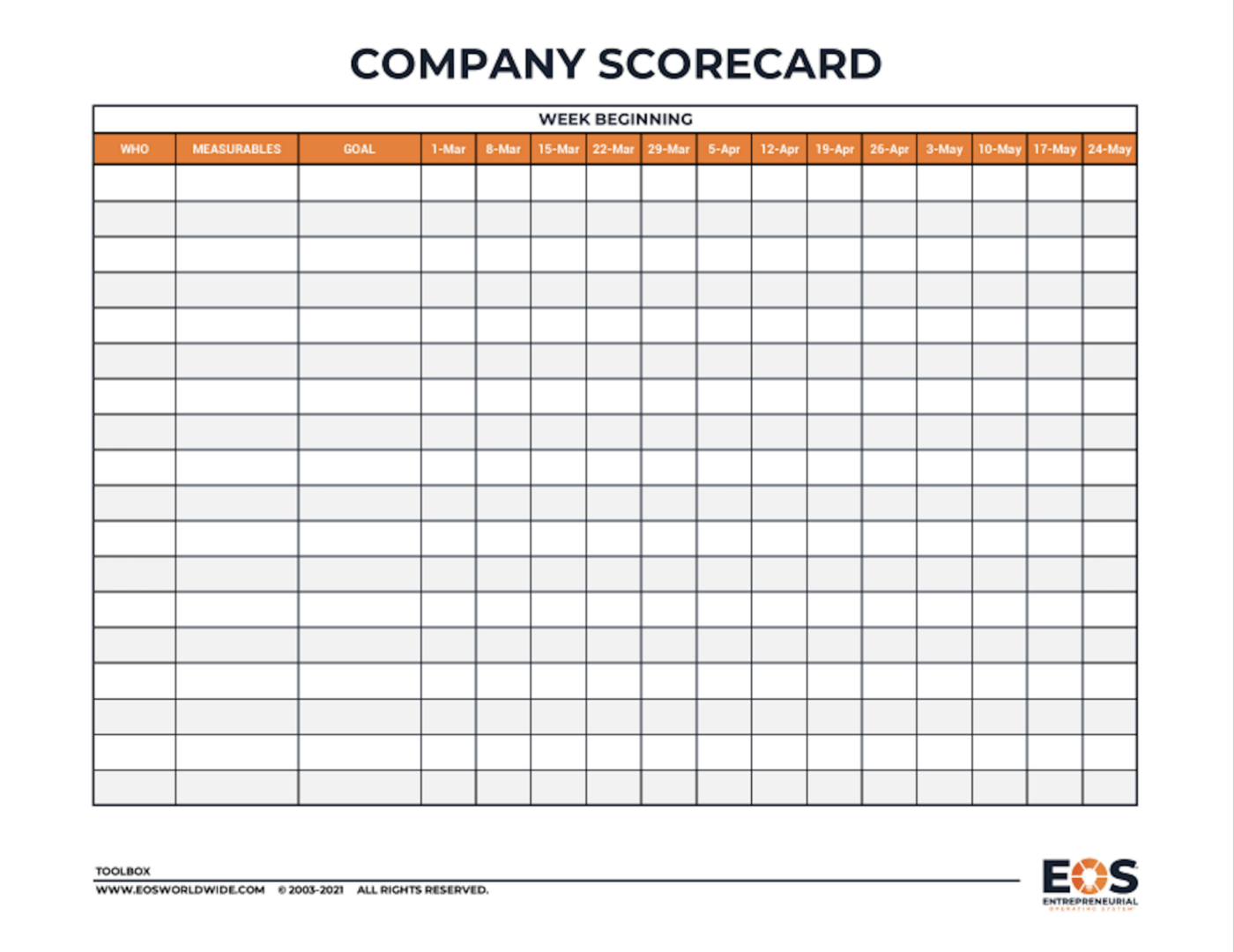
Developed as a tool by EOS Worldwide, the Scorecard has become essential for implementing EOS. It’s a free tool, downloadable on the company’s website. It keeps track of core processes and who is responsible for them within your organization every week.
The key to maintaining a great EOS scorecard is simplicity. Focus on the tasks most essential for your business vision and core values, and assign only the primary leads. Then, make discussing it a part of all your meetings to keep leaders and employees on track with what the organization needs to achieve.
The more measurable the tasks, the better the scorecard can help you execute your EOS process.
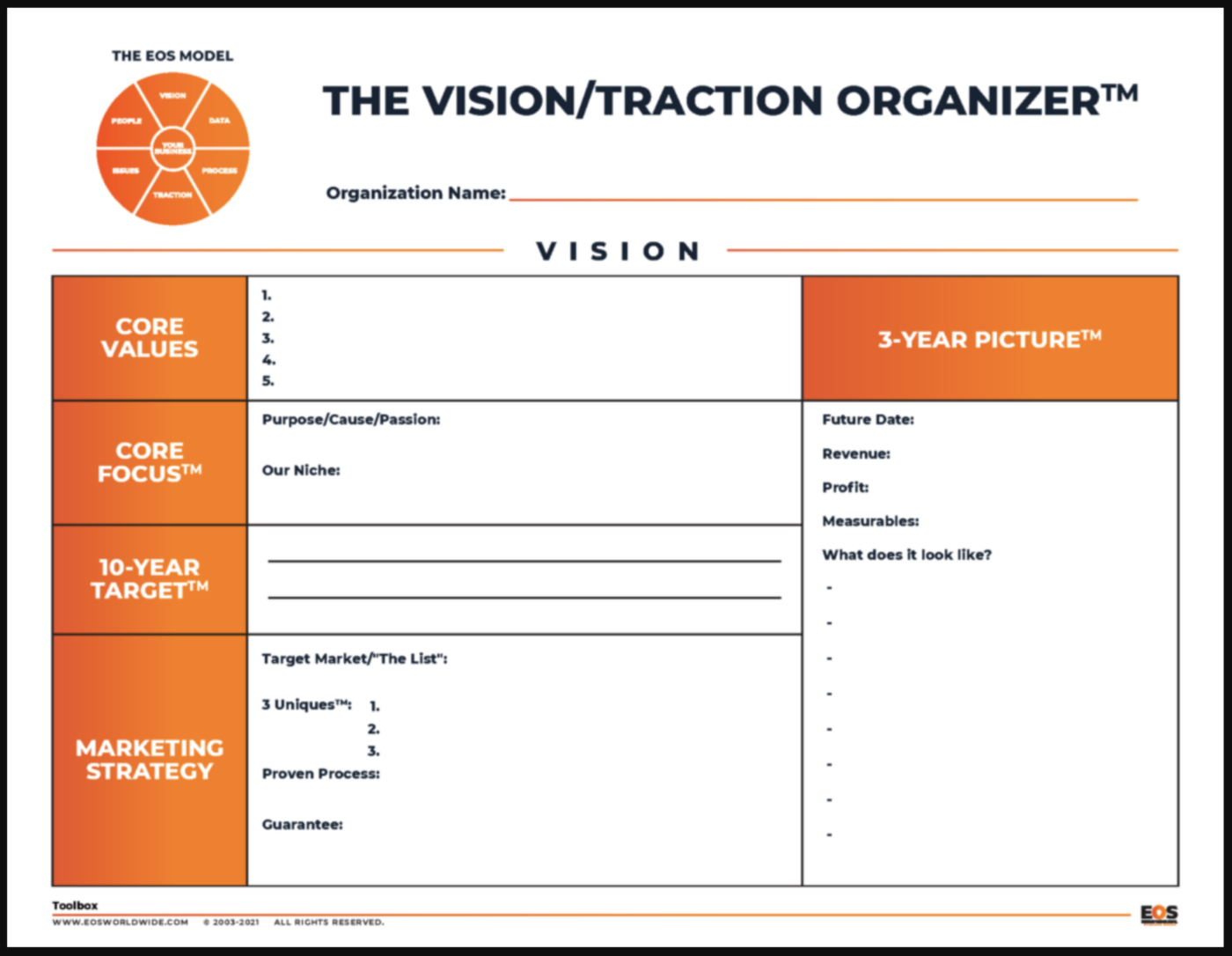
Like the EOS Scorecard, the Vision/Traction Organizer is a free entrepreneurial operating system software built by EOS Worldwide to help simplify the strategic planning process, turn your company’s vision into a formal document, and clarify your company’s future. EOS Worldwide calls the VTO the most essential tool for any organization looking to implement an EOS framework.
It starts with a vision page, which identifies your business’s core values, focus, and targets. From there, it goes into your traction page, where you narrow down your targets to the next 12 months while highlighting “rocks” (the critical priorities of your business) along with potential issues that might prevent you from achieving them.
Keeping it simple allows leaders and companies to keep their eye on the ball, focusing their energy on only what matters most to help the business succeed.
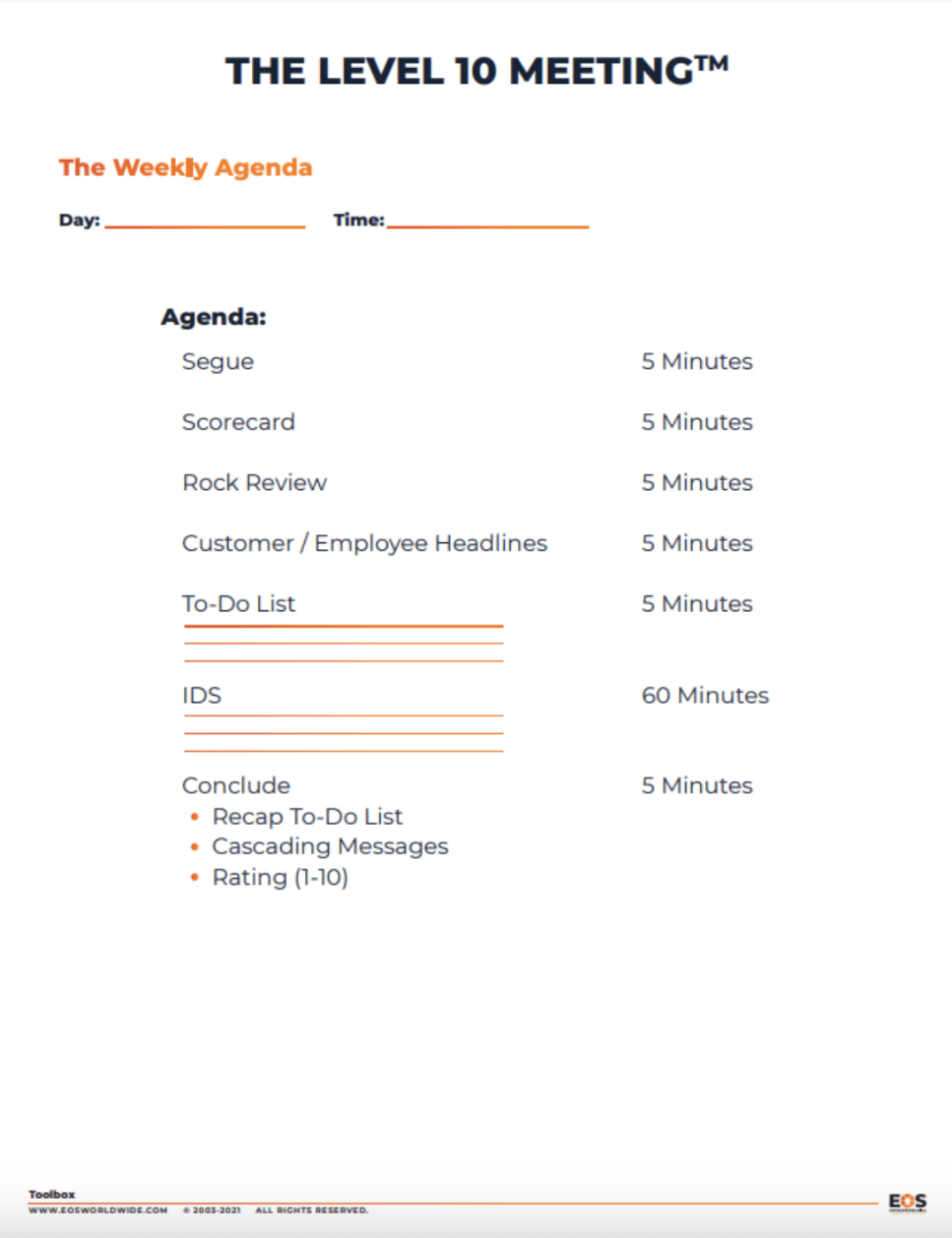
EOS has also created a framework around the concept of Level 10 Meetings. These meetings help structure any conversation and collaborative efforts between leaders and employees. The goal is to keep your business focused on what matters most in all conversations while also focusing everyone’s energy on solving the issues that can drive the business forward.
Level 10 Meetings all follow the same structure. That structure includes a meeting goal, a clear definition of attendees and their roles, and pre-built discussion questions for everyone to understand where the conversation will go. It will also address critical priorities, KPIs, and the next steps your team needs to take to ensure that anything discussed in the meeting will become actionable for your team.
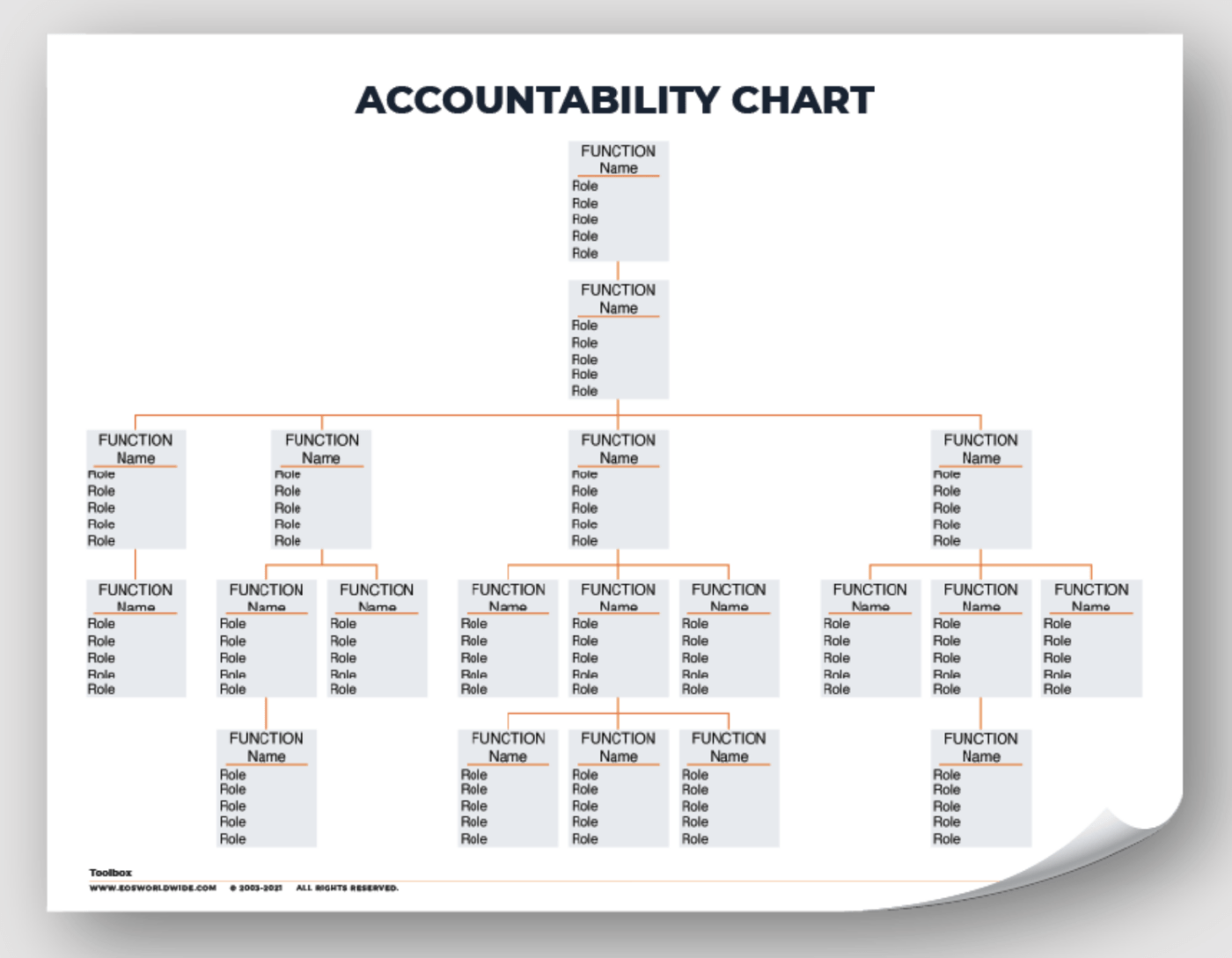
Most businesses think in terms of org charts. In an EOS approach, that concept gets adjusted so that your business can start thinking about accountability instead.
It’s a tool that doesn’t just define who reports to whom. Instead, it describes the roles and responsibilities of everyone in the organization. Doing this builds a culture of accountability for everyone involved.
Like the traditional org chart, this alternative is a network of boxes. Each box includes the role title, the team member’s name, and up to five actions for whom they are responsible. From there, it’s just about connecting the boxes to define the relationships between each role and responsibility.
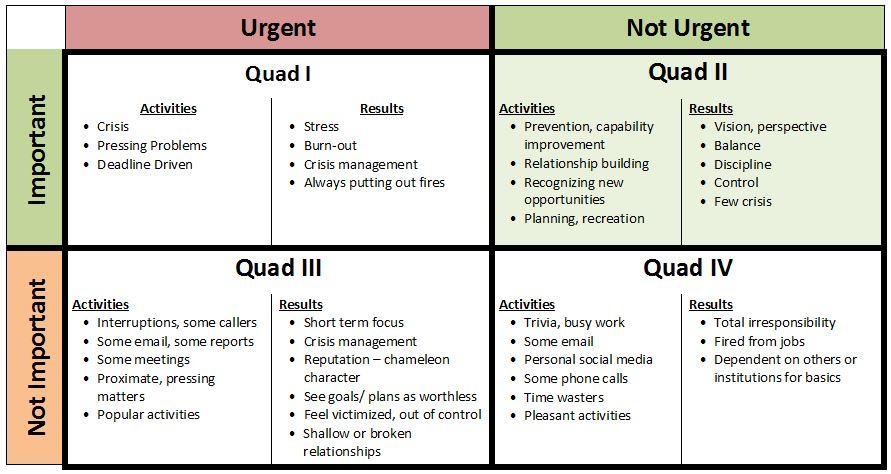
The larger EOS framework defines business priorities as rocks. Managing these rocks takes on a standardized approach from which companies across industries can benefit.
The idea is to turn project management on its head. It offers a new way for companies to stay on track with their goals.
Define between three and seven rocks within your entrepreneurial operating system software each quarter. Then, build specific tasks and roadmaps to accomplish them. Each rock directly connects to your business vision and can quickly scale up or down depending on available resources.
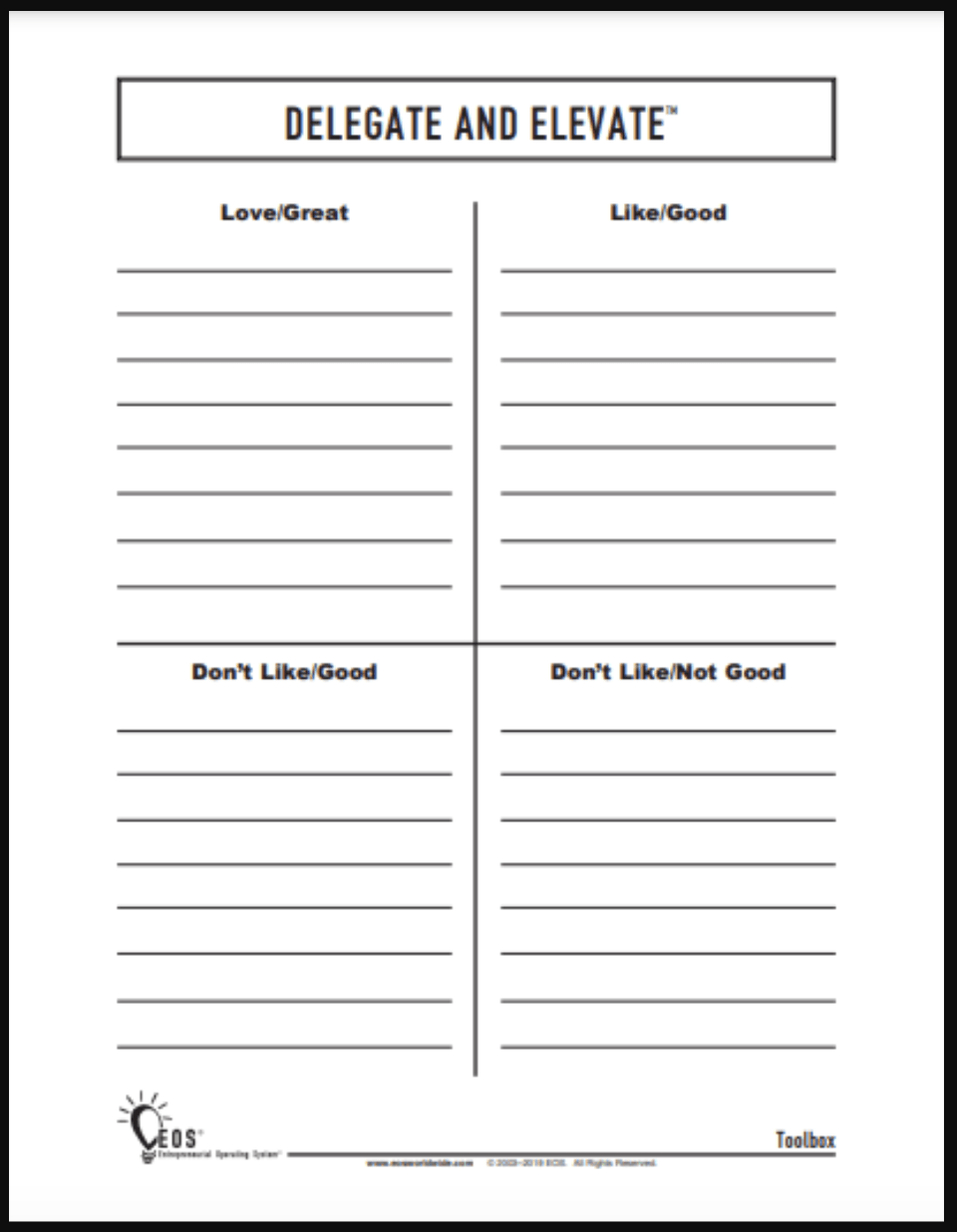
The concept of Delegate and Elevate is another EOS tool coined by EOS Worldwide. It describes that your business can accomplish tasks if the right people in the right seats focus on the right priorities. That way, everyone in the company maximizes their talents and time to help with the larger business process.
At its core, this is a self-evaluation process that every employee should go through regularly. List every task you need to accomplish every week. Then, judge whether or not you have the hours available to complete them.
From there, build four quadrants:
Look to delegate tasks from the bottom up. That way, you can focus more of your time on the things you’re great at that also motivate you, ultimately building your efficiency.
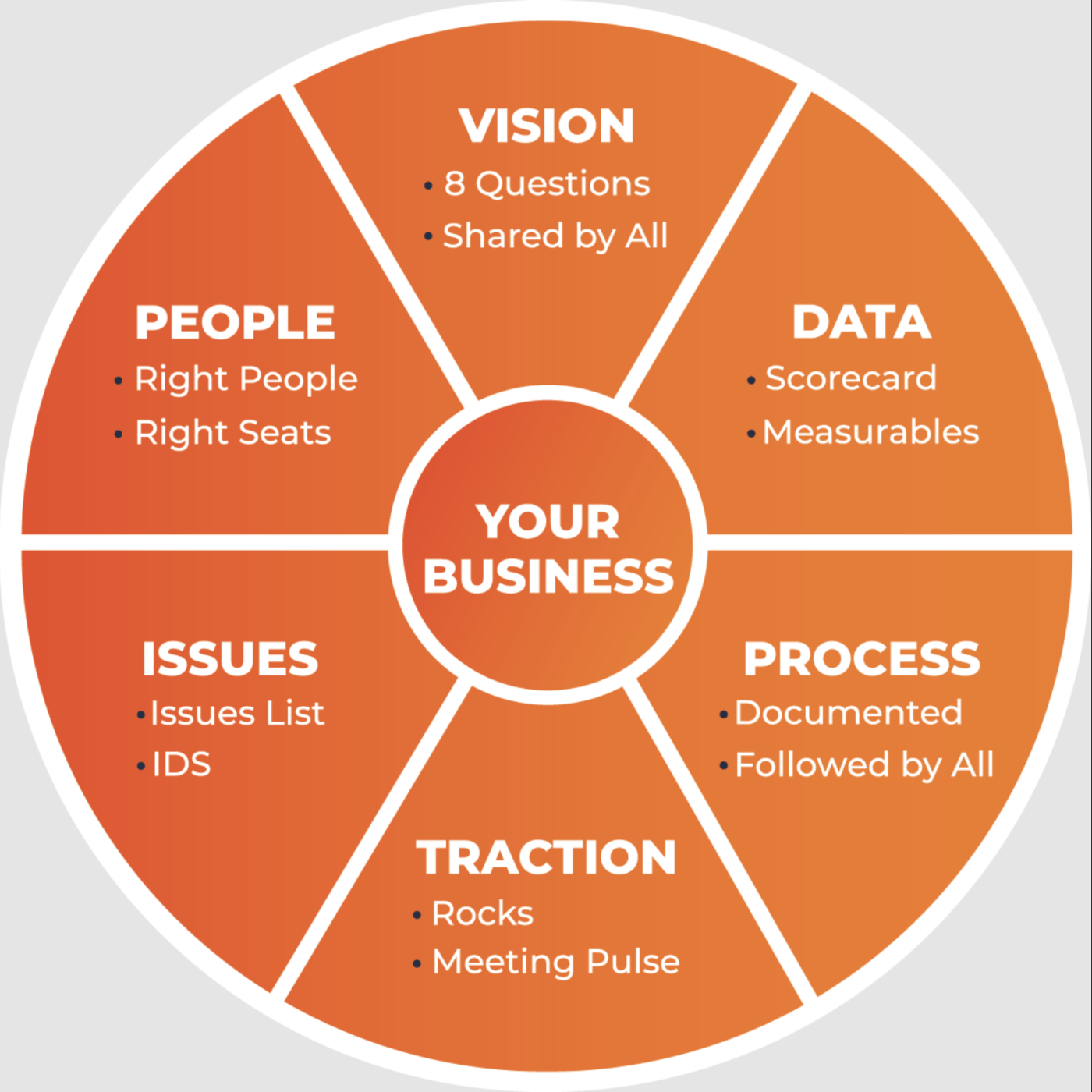
Implementing EOS also means covering an underrated piece of the puzzle many companies ignore—paying attention to the roadblocks in your way. Enter the Issues List, a tool designed to keep those roadblocks on mind for everyone in the organization.
An issue can be anything: a technical issue, a competitive threat, a broken system, or a complaint by a customer or unhappy members of the team.
Everyone on the team should be able to call out an issue. Then, there should be regular discussions on how to solve these issues. Keeping them top of mind can go a long way toward helping your company grow, scale, and succeed.
Finally, don’t underestimate the power of getting feedback from your core stakeholders—both internally and externally. Look for customer feedback tools (and look to leverage those same platforms for your employees) to keep those voices at the top of your mind as you identify your rocks, find your issues, and create your process plans.
Of course, not every tool helping you implement EOS is connected directly to the EOS concept. Consider ClickUp as an example, which is not an entrepreneurial operating system software but can still go a long way toward helping you succeed.
As project management software for small businesses, it’s a versatile way to build a centralized and flexible environment for managing critical components of your EOS. From using it as onboarding software to just tracking your tasks, here’s how ClickUp can support your entrepreneurial operating system:

Through ClickUp’s Project Management features, teams can easily create task lists, prioritize some of their key rocks, and set due dates for these EOS priorities. ClickUp Goals can also help in the process. Updating these key priorities every quarter ensures that everyone in the organization stays on the same page.
Custom dashboards within ClickUps allow users to view their EOS scorecard by tracking performance against predetermined targets. This visual representation of key metrics and objectives also extends to ClickUp Views, which enable you to look at projects and tasks from every possible angle.
A crucial part of EOS is running efficient, goal-oriented meetings. Through task lists and documents, ClickUp can easily be organized to generate, organize, and collaborate on meeting agendas. This promotes more efficient meetings that are aligned with the concept of Level 10 Meetings popularized by EOS.
ClickUp Docs is a key functionality for collaborating on important documents, allowing teams to articulate and share their vision and other strategic pieces. Documents from business plan templates to Vision/Traction Organizers can easily be attached to individual tasks.
Through ClickUp’s customizable features, team leaders can create and manage their Accountability Chart naturally and flexibly. That helps to define roles and responsibilities within the platform better. With this, you can help keep everyone on track to success.
A key component of ClickUp is collaboration, which can go a long way toward issue resolution. Task comments can facilitate discussion, enabling your team to communicate transparently within the platform to work through organizational issues.
Assigning tasks in ClickUp makes it easy for leaders to delegate tasks, spreading the workload evenly across the organization. Meanwhile, ClickUp Task dependencies can help manage and automate workflows. This reduces manual work while ensuring the right order of task completion.
📮ClickUp Insight: 83% of knowledge workers rely primarily on email and chat for team communication. However, nearly 60% of their workday is lost switching between these tools and searching for information. With an everything app for work like ClickUp, your project management, messaging, emails, and chats all converge in one place! It’s time to centralize and energize!
Finally, the highly customizable nature of ClickUp enables your team to tailor their workspace to match EOS processes precisely. Custom fields, statuses, and workflows can all be configured to align with EOS requirements and optimize your processes for efficiency and productivity.
EOS is a robust framework to manage your startup to success. But it can also get complicated. ClickUp’s ability to manage your small business for free goes a long way toward streamlining it all to drive toward business success.
Working through EOS in ClickUp is a whole new way to tackle an already innovative platform.
Ready to get started? Create your free account today!
© 2025 ClickUp